A Real “Spy’s” Every Day Carry (EDC)
We get a lot of questions about “everyday carry,” commonly known as “EDC.” So in light of these requests, we want to provide some insight into our typical EDC and what I carried as a CIA Case Officer (C/O) in Africa and the Middle East.
A timepiece is a crucial and often overlooked part of EDC. Like most tools, a cheap and reliable watch like a Casio F-91W will do, but one shouldn’t be limited to those basic qualifications. EDC is based on practicality but also an expression of one’s preferences, personality, and profession. A mechanical watch also prevents the risk of battery failure, something that always happens at the wrong time. While operational, a Case Officer’s EDC (and watch) should support one’s cover for action, cover for status and task.

Arabic Seiko (Photo Credit: James Rupley)
Caveats: Firstly, W.O.E. is not a “prepper” or an EDC expert. There are men and women who devote their lives to being prepared for the unthinkable: it is a hobby, a passion and a lifestyle. It is tempting to write them off as tin foil hat-wearing paranoids, but, as we’ve learned over the past few years, a little planning can go a long way. Second, I do not consider myself a “gear guy.” Despite my love for timepieces, I am a minimalist at heart and live by the Bror Von Blixen quote that, “It is wisest not to think of what one must have with one, but what one can do without.” Travel light, move fast. As an instructor at the “Farm” told a group of CIA trainees during the “crash and bang” course many years ago, your most important “tool” is the one between your ears.

That said, I have spent much of my adult life living in “dangerous” places and have seen society break down into coups, political violence, terrorism, turmoil, and even war. As a CIA Case Officer, you are a student of the dark side of humanity and develop a deep understanding that the world is not all flowers and rainbows; bad things happen. The US Government spent considerable time and money training our cadre on how to stay safe while collecting intelligence, an activity that takes place at times and locations that are outside of most people’s comfort zone. This experience makes you put thought into the items you carry–in other words, your “EDC.”
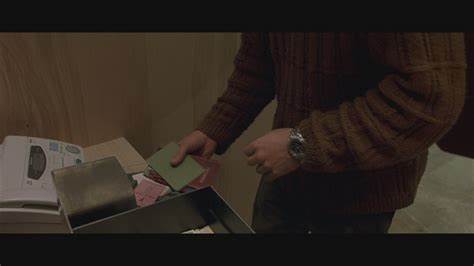
Jason Bourne collecting his tools, TAG Heuer Link Chronograph on wrist (Photo Credit: Universal)
Hollywood vs Reality: Spy thrillers inevitably have a scene where the protagonist visits a safe deposit box, train station locker or local fixer to secure his or her gear; usually alias passports, cash, weapons and spy gadgets. While entertaining, this is not the norm for CIA officers operating overseas. Besides the fact that tradecraft dictates operational acts should avoid heavily surveilled areas like train stations and banks, the truth of a CIA officer's EDC is more mundane, but no less interesting.

A real "Spy watch" (Photo Credit: Ultimate Spy, Keith Melton)
Spy Gear: There are a lot of misconceptions about the tools CIA Case Officers leverage to recruit spies and steal secrets. Perpetuated by Hollywood, many Americans probably think C/Os are crawling through air ducts with knife blades hidden in their shoes, watches that shoot laser beams and submachine guns hidden in briefcases. While there were times that I leveraged “spy gear,” most of my career I used simple but effective tools to accomplish my mission. My personal EDC items, or non-negotiables, were a pocket knife; Pilot G2 pen and paper (3x5 cards); flashlight; a watch; pocket calendar; passport or local identification card and money (a minimum of $300 in multiple currencies and denominations). Tourniquets, paper maps, light disguise and cover-supporting items were always within reach in either a messenger bag or non-American brand backpack.

Case Officers and Watches: The watch was crucial. An intelligence operation is a carefully choreographed dance where accurate timekeeping is mission-critical. Missing a clandestine operational meeting, a surveillance detection cover stop, or a dead drop signal by seconds can mean the difference between operational success and high-stakes failure. Cell phones and smart watches were unacceptable during operations. A reliable timepiece is a necessity to ensure you conduct your operational act (agent meeting) at the exact time and place without leaving behind a digital footprint that can be pieced together by a competent hostile intelligence service.
CIA-Issued Watch: There is no “CIA-issued watch.” The very idea contradicts a C/O’s requirement to operate alone and wear nothing identifiable. While CIA officers can use a “war-zone stipend” to procure a watch, the majority of C/Os I know purchase watches on their own dime. We are aware of at least three mechanical CIA “unit watches,” but unfortunately cannot go into details on these at this point. While data is shaky, today the vast majority of C/Os probably rely on digital tool watches (DTW). That said, there is a strong watch culture at CIA and you will see just about every brand while walking the halls of CIA or in the field.

Africa Division Challenge Coin and W.O.E.'s personal IWC (Photo Credit: James Rupley)
Looking back at pictures of the years I was at CIA, the most common watches on my wrist appeared to be an IWC Mark XVII, an older Rolex GMT Master II 16710 and the Breitling Aerospace, which was a gift from King Abdullah of Jordan. They are versatile “go anywhere” watches that can fit in with a suit and tie at a diplomatic function in Europe or jeans and a dirty t-shirt in the African bush. The Breitling and IWC are not overly flashy and do not draw undue attention.

(Photo Credit: Tom Brenner)
Cash is King: One thing the movies get right is the utility of cash in espionage for source payments, travel expenses and meals. Cash is untraceable and mitigates the digital trail left by credit cards and other electronic means of payment. As a rule, I kept a minimum of $300 in cash on me at all times (still do), in addition to spending money and cash for asset payments. The number is relatively arbitrary but $300 in the local currency and USD in multiple denominations can get you out of most situations. In addition to the counterintelligence implications of using a credit card, there are many places I worked where credit card machines were simply not available or reliable.

Cash is King, Zenith El Primero.
Firearms: Depending on the assignment, C/Os are trained extensively and regularly qualify on pistols and long guns. Firearm proficiency was a requirement for every overseas post I served, but guns are not a critical tool of intelligence collection. C/Os are not assaulters, and if they must use a firearm, something has gone seriously wrong. It was a last resort. Regardless of your cover (ie your supposed reason for being in that country) a pistol is generally not easily explained away. If pulled over or questioned by police, it is difficult to articulate why you have a pistol or long gun in your car. In most countries, an unregistered firearm will result in an arrest, a late night call to the US Ambassador, and potential expulsion from the country. Worse, it will highlight you as a potential Intelligence Officer, making your job significantly more difficult.

Original art by W.O.E.
Pocket Knife: While many European countries prohibit carrying pocket knives, a ~3 inch folding blade can generally be explained away. In most of the developing world, a pocket knife is not abnormal and is carried by diplomats, NGO workers or local businessmen. While situationally dependent, in the areas I served it was not a “tell.” I had and continue to use higher end blades such as Emerson and Half Face Blades, but I preferred to carry cheaper folding blades such as a Spiderco concealed inside the waistband. If needed, I could throw the blade into a river, storm drain or trashcan and not feel like I lost a month's salary. Like watches, knives are tools. Also like watches, there are many levels when it becomes a hobby.
Flashlight: As a C/O, much of your work occurs at night in back alleys, parks or hunkered in a car. Flashlights are a crucial part of your kit for taking notes and navigating your way through wooded areas. (Again it's hard to explain why you have night vision if detained.) As a primary flashlight, I carried a Surefire Defender. The light features a toothed bezel for striking and an impressive 600+ lumens that can temporarily blind an attacker. My secondary flashlight was a penlight attached to my keychain, likely more useful than the former.

Tools, Surefire, Push light, Pocket Knife, Rowing Blazers x Zodiac Super Sea Wolf
Asp & pepper spray: Two other defensive tools I leveraged were an asp and pepper spray. I only extended the asp a couple times in my career, all of which were to ward off packs of feral dogs, often a greater risk than the local intelligence service or petty criminals. I never felt comfortable with pepper spray but did keep it in my vehicle just in case.
“Blend in” vs “Stick Out”: The vast majority of Americans (or C/Os) will not blend in as locals in Africa, Asia, the Middle East or Latin America. While operational at CIA, my goal was not to necessarily blend in as a local, but to avoid sticking out–to be the “gray man”: to look like any other western person in that country. As we have previously discussed, this includes the watch. That tactical G-Shock on the inside of your wrist, American flag baseball hat, Oakley sunglasses and beard make you stick out, and not in the way you want.

Artistic satire of a CIA Case Officer “blending in” somewhere in the Middle East. (Photo Credit: Team America)
Expeditionary Warzone EDC: During the Global War on Terror (GWOT), CIA officers received a stipend to purchase clothing and gear. In contrast to the military, CIA officers do not want to look the same as each other and officers can decide on the gear that works for their environment. In the early years of the wars in Iraq and Afghanistan, there was a lot of contractor-chic (5.11, shemagh, etc). In later years most CIA officers wore civilian non-tactical clothing. During my last trip to a war-zone, I wore blue jeans, t-shirts and button down shirts to conceal my pistol: Crye Precision Jump Plate Carrier 2.0, Glock 19 concealed in a Tenicor holster. Long guns were generally a mixture of AR-15/M-4 platforms from at least three different manufacturers. Optics, slings and accessories were assignment-dependent ie what was available in that country. You go to war with the tools you have.

CIA’s Team Alpha Prior to Insertion into Afghanistan. J.R. Seeger Back Row, Third From Left (Photo Credit: CIA)
Current Everyday Carry: As a former C/O turned watch influencer, my present day EDC is informed by my past but adapted to my current environment. We understand that firearms are a polarizing issue in the watch community, however, for many formers from the NatSec community, a pistol is a crucial part of our EDC.
Pistol: With few exceptions, I always carry a Glock 43 with an extended magazine in a leather SOB Condom Holster and a spare magazine. I landed on this set up due to its concealability and comfort. My philosophy on EDC is to carry what you will actually carry. If something is too large or uncomfortable, you will end up leaving it at home and not having it on you when you need it. While I prefer the larger Glock 19, I find myself deferring to the smaller, more concealable version. I travel periodically to states/cities with capacity restrictions which make the smaller pistol convenient (legal).

Knife: If I am not carrying a pistol, I have a fixed blade on me, concealed inside the waistband. My go-to is the Dynamis Alliance by Winkler Knives. To be clear, I do not consider myself a knife fighter. This is a last resort item.
Timepiece: Today, my daily watch choice is dictated more by interests than utility. That said, the watch is generally matched for the activity and environment. If I am doing something active with the potential to get wet, I will wear a more robust Tudor Pelagos. If the activity is more social, I may wear a vintage piece like my Rolex GMT Master II “Root Beer” 16753.
Overseas: Most of my operational activity occurred in Africa and the Middle East, but I have spent and continue to spend much of my time traveling the world for personal and professional reasons.
There are plenty of locations in the United States and abroad where it is not feasible to carry a pistol or fixed blade. If you are reliant on a firearm for protection, you will likely be out of luck. The Surefire flashlight is still my go-to tool for EDC while traveling internationally or domestically. It can legally be carried on an airplane and does not raise questions.
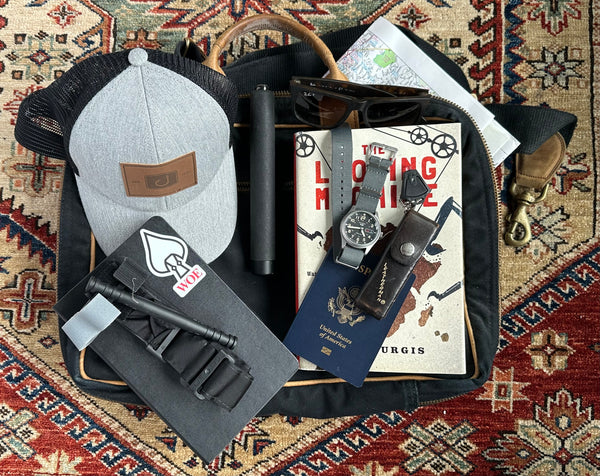
Tourniquets, paper maps, light disguise and cover-supporting items were always within reach in my Sandstorm “man purse.”
I generally travel with at least two watches and use the W.O.E. Travel Pouch for the one I’m not wearing. When traveling through major transit hubs like train stations and crowded public areas, the pouch is narrow enough to slide in a front pocket.
Mindset: Despite the time that we put into this article, people spend too much time thinking about gear and EDC items. At the end of the day, the tools do not make the man and the most important tool is still the one between your ears: “It's the Indian, not the arrow.” Knowledge, training, experience, interpersonal skills and physical fitness are not only going to keep you alive but allow you to thrive in any given situation.
Get out there, use your tools.
--
If you enjoyed this article, please consider signing up for our weekly free newsletter for further updates HERE.
EDC Travel Valet & Bottle Opener - Available
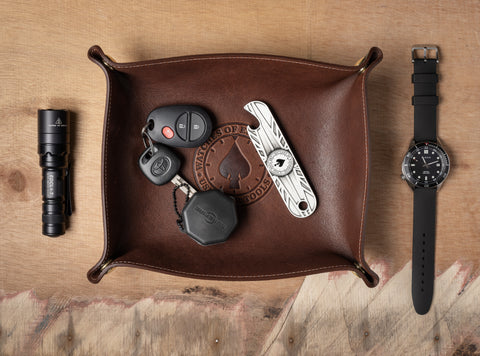
Read Next: Timepiece Crime And Traveling With Watches, Africa Watch Loadout
This article has been reviewed by the CIA's Prepublication Classification Review Board to prevent the disclosure of classified information.
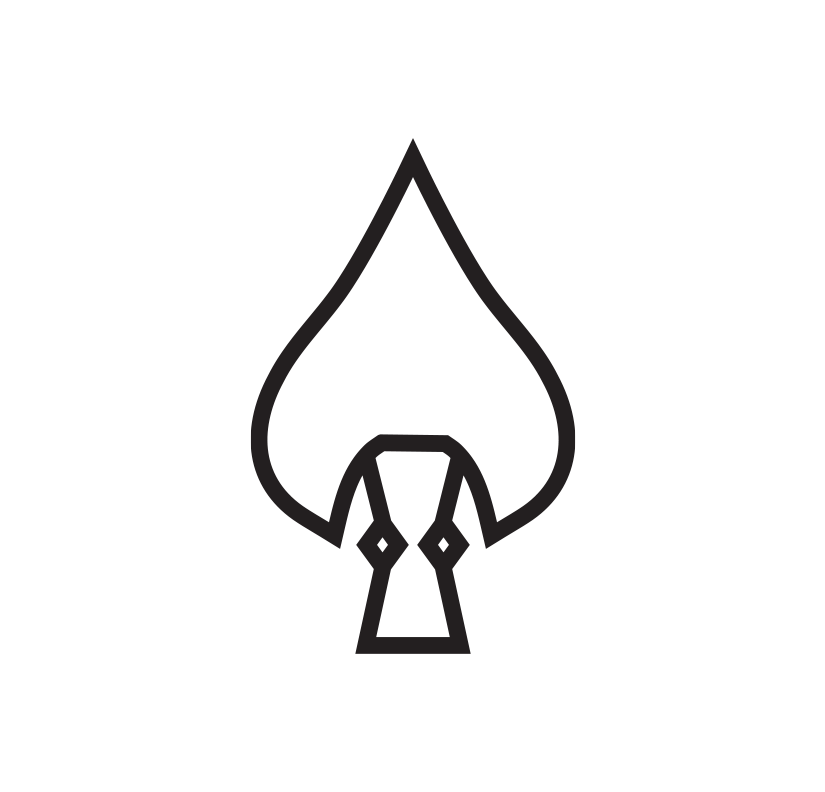
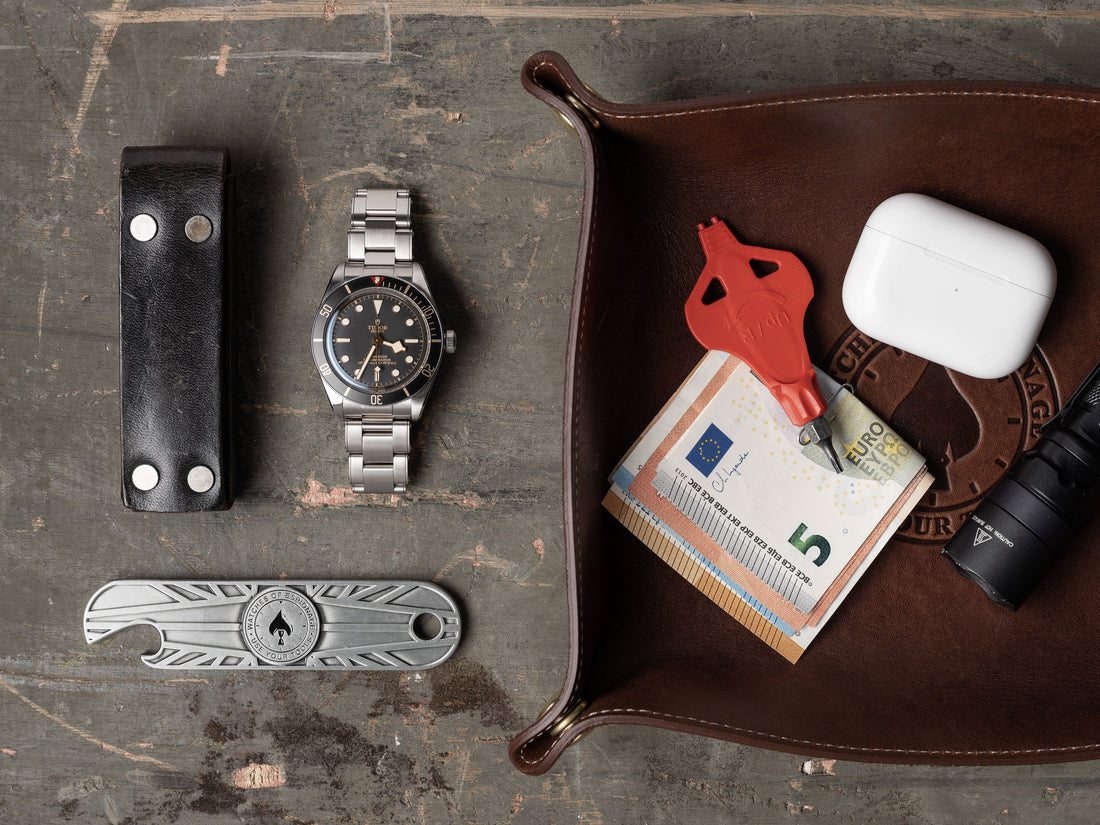






20 comments
Entertaining read but VERY Hollywood. Either way, nice job.
I shared this essay with my classmates. I’m currently undergoing training as a Foreign Service Officer (Department of State) as of March 2024.
In class, we were told to carry ~$300 of currency by a (retired CIA) instructor. Instantly, I recalled this article you wrote last year. We were also presented with a range of EDC tools and we were asked to write in detail why we would/wouldn’t carry one or more particular item.
FYI: The timepieces I have noticed at our training center range from a few high-end Rolex, Panerai, Breitling to many Casio, Seiko, and Citizen on the wrists of instructors and students. I choose to wear a simple Citizen Garrison titanium watch in a leather strap.
Please keep up the good work. I’ll continue to read your material and shop from your store.
God Bless America!
Pat
“The risk of battery failure” has been mentioned a number of times in the past, yet Citizen and Seiko ‘Eco-drive’ and ‘Solar’ watches are never mentioned. Being Quartz they are more rugged, reliable and accurate than a mechanical watch. My 20 year old Citizen “Ray Mears” Promaster Tough ( 7828-H09971 TA GN-4W-UL) is nearly as rugged as a G-Shock, has never been serviced and has gained 5 seconds a week since new. I has an innocuous “Field” watch design and would be a great ’Operator’s’ watch.
The Seiko SNE range of Dive watchs meet the criteria of rugged, reliable, good looking “Toyota” watches that come under the $1000 purchase price, my favorite being the SNE573. It gains 1-2 seconds a week and I don’t expect to loose it’s use for a service in the next 20 years.
What model is the Spyderco knife? Thanks
Very cool article. It’s a nice change to see someone that has a minimalist approach to their EDC and actually uses their gear. Quite a contrast to much of the EDC folks with loads of shiny, unblemished pocket litter.
Really dig the SureFire lights… I’ve been carrying that same defender just about everyday for the last 12 years or so.